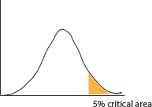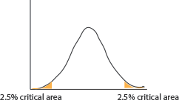Chapter 8 One- or two-tailed test?
In inferential statistics, we solve an of area-under-the-curve problem to calculate p. If p is very low, then we can conclude that our sample did not come about by chance-something else is going on.
Two-tailed tests (the most common) are used to test whether a sample mean is different from the population mean. Two-tailed tests are used when the prediction does not have a direction (e.g., “I think this test prep course will lead to either higher or lower test scores” or “I want to find any effects, good or bad, of this workshop”).
One-tailed tests are used to test a specific prediction about the sample mean being higher or lower than the population mean (e.g., “I think this test prep course will lead to higher test scores”).
This affects your statistics because it changes what you consider to be rare. In a one-tailed test, the critical region (what you consider to be rare) is only on one side of the sampling distribution:

Normal distribution with the upper five percent shaded and labeled as the critical area
One-tailed test. Figure shows the sampling distribution of the mean. In a two-tailed test, the critical region (what you consider to be rare) is on both ends of the sampling distribution:
 Two-tailed test. Figure shows the sampling distribution of the mean.
Two-tailed test. Figure shows the sampling distribution of the mean.